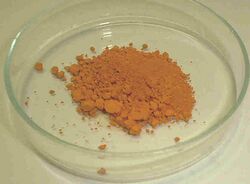Chrome orange

Chrome orange is a mixed oxide with the chemical formula Pb2CrO5. It can be made by treating a lead(II) salt with an alkaline solution of a chromate or by treating chrome yellow (PbCrO4) with strongly basic solution.[2]
Synthesis and nanoparticles
Pb2CrO5 can be synthesized with a gas-liquid precipitation process.[3] Changing the pH controls whether PbCrO4 or Pb2CrO5 is created.[3]
Orthorhombic nanocrystals can be selectively synthesized in a facile room temperature solution for Pb2CrO5.[4]
Using a microwave-assisted ionic liquid (MAIL) method, bundle and rod-like nanocrystals of Pb2CrO5 were formed.[5] The bundles look like bundles of straw, secured in the middle.[5] In basic solution, single-crystalline Pb2CrO5 could be formed by heating lead acetate and potassium dichromate with microwave radiation for only 10 minutes at 90 celsius.[5] The MAIL process is simple, fast, and does not employ surfactants.[5] The presence of hydroxide changes the phase that is formed. Using NaOH, monoclinic Pb2CrO5 is formed.[5] The bundle and rod-shaped structures are sensitive to electron beam irradiation, which will turn them into many small particles.[5]
Properties
The Gibbs free energy of Pb2CrO5 was determined in 2010 and is given as
ΔfG°mPb2CrO5(s)±0.30/(kJ•mol−1)=-1161.3 +0.4059(T/K) (859≤T/K≤1021).[6]
Visible light activity up to 550 nanometers has been recorded for Pb2CrO5.[7]
Pigment synthesis
In an catalog published c. 1835, Winsor and Newton paint company identify ten synthetic pathways for producing chrome orange, also called deep yellow.[8] Chrome orange is made of PbCrO4 mixed with basic lead chromate (Pb2CrO5).[8] It has been described as a “yellowish red or sometimes a beautiful deep red” in alkaline conditions.[8] A deep yellow can be created using PbCrO4 and lead sulfate.[8] There are ten synthetic methods for preparing deep chrome yellow (that made with Pb2CrO5), which require a chromate source, a basic lead source, additives, and a sulfate source.[8] CrO42- + H2SO4+Pb(Ac)2 • 2Pb(OH)2 → PbCrO4+Pb2CrO5 at a pH of approximately seven is the synthesis.[8]
Controlling the pH was Winsor and Newton’s method for creating pigments from the pale yellow to the deep chrome orange.[8] The resulting product has a high stability to light, which is always coveted by artists and collectors.[8]
History
The natural mineral crocoite was discovered in 1797 by Louis Vauquelin and chrome orange was synthesized as a pigment for the first time in 1809.[9] Pb2CrO5 is found in mineral form as phoenicochroite, which is a monoclinic, red, translucent mineral found in various places across the world, including Russia, the USA, and Chile.[10]
Use as a pigment
| Chrome Orange | |
|---|---|
| Hex triplet | #E73501 |
| Source | ColourLex[11] |
Chrome orange can range in color from light to deep orange and is no longer in production as a pigment.[9] It has also been known as Derby red, Persian red, and Victoria red.[9] It was first recorded as a pigment in 1809 and was perfect for some impressionist painters in the nineteenth century. The yellow-orange pigment of the boat in Renoir’s 1879 painting, The Seine at Asnières (The Skiff) at the National Gallery, London.[9] Chrome orange was used extensively in Frederic Leighton's Flaming June (1895; Museo de Arte de Ponce).[1]
See also
References
- ↑ 1.0 1.1 Color in the Making. London, UK: Black Dog Publishing. 2013. p. 104. ISBN 9781907317958.
- ↑ Völz, Hans G. (2006). "Pigments, Inorganic". Ullmann's Encyclopedia of Industrial Chemistry. Weinheimdoi=10.1002/14356007.a20_243.pub2: Wiley-VCH. doi:10.1002/14356007.a20_243.pub2. ISBN 3527306730..
- ↑ 3.0 3.1 Gu, LiNa; Meng, GuangYao (2007-09-05). "Synthesis and characterization of two PbO-chromium oxides" (in en). Powder Technology 178 (1): 1–4. doi:10.1016/j.powtec.2007.01.017. ISSN 0032-5910. https://www.sciencedirect.com/science/article/pii/S0032591007000198.
- ↑ Ma, Ming-Guo; Zhu, Ying-Jie; Li, Shu-Hong (2009-02-04). "A simple route to the synthesis of BaCrO4 microstructures at room temperature" (in en). Materials Research Bulletin 44 (2): 288–293. doi:10.1016/j.materresbull.2008.06.003. ISSN 0025-5408. https://www.sciencedirect.com/science/article/pii/S0025540808002067.
- ↑ 5.0 5.1 5.2 5.3 5.4 5.5 Wang, Wei-Wei; Zhu, Ying-Jie (2005-03-01). "Synthesis of PbCrO 4 and Pb 2 CrO 5 Rods via a Microwave-Assisted Ionic Liquid Method" (in en). Crystal Growth & Design 5 (2): 505–507. doi:10.1021/cg0497546. ISSN 1528-7483. https://pubs.acs.org/doi/10.1021/cg0497546.
- ↑ Sahu, Sulata Kumari; Ganesan, Rajesh; Gnanasekaran, T. (2010-01-01). "Standard molar Gibbs free energy of formation of Pb5CrO8(s), Pb2CrO5(s), and PbCrO4(s)" (in en). The Journal of Chemical Thermodynamics 42 (1): 1–7. doi:10.1016/j.jct.2009.06.026. ISSN 0021-9614. https://www.sciencedirect.com/science/article/pii/S0021961409001748.
- ↑ Lee, Heung Chan; Cho, Sung Ki; Park, Hyun S.; Nam, Ki Min; Bard, Allen J. (2017-08-24). "Visible Light Photoelectrochemical Properties of PbCrO 4 , Pb 2 CrO 5 , and Pb 5 CrO 8" (in en). The Journal of Physical Chemistry C 121 (33): 17561–17568. doi:10.1021/acs.jpcc.7b03230. ISSN 1932-7447. https://pubs.acs.org/doi/10.1021/acs.jpcc.7b03230.
- ↑ 8.0 8.1 8.2 8.3 8.4 8.5 8.6 8.7 Otero, Vanessa; Pinto, Joana V.; Carlyle, Leslie; Vilarigues, Márcia; Cotte, Marine; João Melo, Maria (2017). "Nineteenth Century Chrome Yellow and Chrome Deep from Winsor & Newton". Studies in Conservation 62 (3): 123–149. doi:10.1080/00393630.2015.1131478.
- ↑ 9.0 9.1 9.2 9.3 "Pigments through the Ages - Overview - Chrome orange". http://www.webexhibits.org/pigments/indiv/overview/crorange.html.
- ↑ "Phoenicochroite". https://www.mindat.org/min-3194.html.
- ↑ "Chrome orange - ColourLex". https://colourlex.com/project/chrome-orange/.
Further reading
- Kühn, H. and Curran, M., Chrome Yellow and Other Chromate Pigments, in Artists’ Pigments. A Handbook of Their History and Characteristics, Vol. 1, L. Feller, Ed., Cambridge University Press, London 1986, p. 208 – 211.
- Chrome Orange at ColourLex
 |


